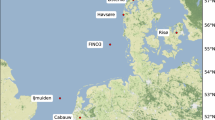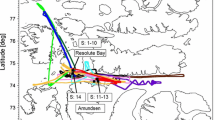Abstract
Models of the diabatic wind profile over homogeneous terrain for the entire atmospheric boundary layer are developed using mixing-length theory and are compared to wind speed observations up to 300 m at the National Test Station for Wind Turbines at Høvsøre, Denmark. The measurements are performed within a wide range of atmospheric stability conditions, which allows a comparison of the models with the average wind profile computed in seven stability classes, showing a better agreement than compared to the traditional surface-layer wind profile. The wind profile is measured by combining cup anemometer and lidar observations, showing good agreement at the overlapping heights. The height of the boundary layer, a parameter required for the wind profile models, is estimated under neutral and stable conditions using surface-layer turbulence measurements, and under unstable conditions based on the aerosol backscatter profile from ceilometer observations.





Similar content being viewed by others
References
Batchvarova E, Gryning S-E (1991) Applied model for the height of the daytime mixed layer. Boundary-Layer Meteorol 56:261–274
Blackadar AK (1962) The vertical distribution of wind and turbulent exchange in a neutral atmosphere. J Geophys Res 67:3095–3102
Blackadar AK, Tennekes H (1968) Asymptotic similarity in neutral barotropic planetary boundary layers. J Atmos Sci 25:1015–1020
Businger JA, Wyngaard JC, Izumi Y, Bradley EF (1971) Flux-profile relationships in the atmospheric surface layer. J Atmos Sci 28:181–189
Carl DM, Tarbell TC, Panofsky HA (1973) Profiles of wind and temperature from towers over homogeneous terrain. J Atmos Sci 30:788–794
Courtney M, Wagner R, Lindelöw P (2008) Testing and comparison of lidars for profile and turbulence measurements in wind energy. Earth Environ Sci Conf Ser 1:012 021 (14 pp)
Emeis S, Münkel C, Vogt S, Müller WJ, Schäfer K (2004) Atmospheric boundary-layer structure from simultaneous SODAR, RASS, and ceilometer measurements. Atmos Environ 38:273–286
Emeis S, Schäfer K (2006) Remote sensing methods to investigate boundary-layer structures relevant to air pollution in cities. Boundary-Layer Meteorol 121:377–385
Emeis S, Schäfer K, Münkel C (2008) Surface-based remote sensing of the mixing-layer height—a review. Meteorol Z 17(5):621–630
Eresmaa N, Karppinen A, Joffre SM, Säsänen J, Talvitie H (2006) Mixing height determination by ceilometer. Atmos Chem Phys 6:1485–1493
Estoque MA (1973) Tower micrometeorogy. In: Haugeb DA (ed) Workshop on micrometeorolgy. American Meteorology Society, Boston, pp 217–270
Foken T (2006) 50 years of the Monin-Obukhov similarity theory. Boundary-Layer Meteorol 119:431–447
Grachev AA, Fairall CW, Bradley EF (2000) Convective profile constraints revisited. Boundary-Layer Meteorol 94:495–515
Gryning S-E, Batchvarova E, Brümmer B, Jørgensen H, Larsen S (2007) On the extension of the wind profile over homogeneous terrain beyond the surface layer. Boundary-Layer Meteorol 124:251–268
Hess GD, Garratt JR (2002) Evaluating models of the neutral, barotropic planetary boundary layer using integral measures: part i. Overview. Boundary-Layer Meteorol 104:333–358
Högström U (1988) Non-dimensional wind and temperature profiles in the atmospheric surface layer: a re-evaluation. Boundary-Layer Meteorol 42:55–78
Lettau H (1950) A re-examination of the “Leipzig wind profile” considering some relations between wind and turbulence in the frictional layer. Tellus 2:125–129
Lettau HH (1962) Theoretical wind spirals in the boundary layer of a barotropic atmosphere. Beitr Phys Atmos 35:195–212
Lindelöw P, Courtney M, Parmentier R, Cariou JP (2008) Wind shear proportional errors in the horizontal wind speed sensed by foused, range gated lidars. J Phys Conf Ser 1:012 023 (10 pp)
Mann J et al (2008) Comparison of 3D turbulence measurements using three staring wind lidars and a sonic anemometer. Earth Environ Sci Conf Ser 1:012 012 (6 pp)
Monin AS, Obukhov AM (1954) Osnovnye zakonomernosti turbulentnogo peremeshivanija v prizemnom sloe atmosfery (Basic laws of turbulent mixing in the atmosphere near the ground). Trudy Geofiz Inst AN SSSR 24(151):163–187
Obukhov AM (1971) Turbulence in an atmosphere with a non-uniform temperature. Boundary-Layer Meteorol 2:7–29
Ohmstede WD, Appleby JF (1964) Numerical solution of the distribution of wind and turbulence in the planetary boundary layer. Tech. rep., Meteorol. Res. Note No. 8, DA Task 1-A-0-11001-B-021-08 USAERDAAMET-5-64, 43 pp
Panofsky HA (1973) Tower micrometeorogy. In: Haugeb DA (ed) Workshop on micrometeorolgy. American Meteorology Society, Boston, pp 151–176
Peña A (2009) Sensing the wind profile. Tech. Rep. Risoe-PhD-45(EN), Risø DTU, 80 pp
Peña A, Gryning S-E (2008) Charnock’s roughness length model and non-dimensional wind profiles over the sea. Boundary-Layer Meteorol 128:191–203
Peña A, Gryning S-E, Hasager CB (2008) Measurements and modelling of the wind speed profile in the marine atmospheric boundary layer. Boundary-Layer Meteorol 129:479–495
Peña A, Gryning S-E, Mann J, Hasager CB (2009) Length scales of the neutral wind profile over homogeneous terrain. J Appl Meteor Climatol (in review)
Prandtl L (1925) Bericht über untersuchungen zur ausgebildeten turbulenz. Zs angew Math Mech 5:136–139
Prandtl L (1932) Meteorologische Anwendung der Strömungslehre. Beitr Phys Atmos 19:188–202
Rossby CG, Montgomery RB (1935) The layers of frictional influence in wind and ocean currents. Pap Phys Oceanogr Meteorol 3(3):101
Steyn DG, Baldi M, Hoff RM (1999) The detection of mixed layer depth and entrainment zone thickness from lidar backscatter profiles. J Atmos Ocean Technol 16:953–959
Stull RB (1988) An introduction to boundary layer meteorology. Kluwer, Dordrecht, 666 pp
Zilitinkevich SS (1975) Resistance laws and prediction equations for the depth of the planetary boundary layer. J Atmos Sci 32:741–752
Zilitinkevich SS, Mironov DV (1996) A multi-limit formulation for the equilibrium depth of a stably stratified boundary layer. Bound-Layer Meteorol 81:325–351
Acknowledgements
The authors would like to thank the Test and Measurements Program of the Wind Energy Division at Risø DTU for the acquisition of the Høvsøre data, in particular to Michael Courtney, and to Claire Vincent from Risø DTU for the comments on the manuscript and advice on the English language. Funding from The Danish Council for Strategic Research to the projects “12 MW” Sagsnr. 2104-05-0013 and 2104-08-0025 is also acknowledged. I (AP) would like to thank Henrik Søgaard from the University of Copenhagen for the supervision of my PhD.
Author information
Authors and Affiliations
Appendix A: Boundary-layer height from aerosol backscatter
Appendix A: Boundary-layer height from aerosol backscatter
The ceilometer measures the volume backscatter coefficient, β, which is fitted to an idealized backscatter profile using the technique in Steyn et al. (1999). The idealized profile has the form:
where B a is the mean backscatter coefficient above the entrainment layer, B u is the mean backscatter coefficient in the stable, neutral, or unstable layer, and s is related to the depth of the entrainment layer. For each stability class in Table 1, the 10-min backscatter profiles are averaged and a least-squares fit is performed on the average profile using Eq. 15. Profiles that showed an enhanced aerosol backscatter for heights below 1,000 m were removed from the analysis, due to the presence of low clouds. The results of the fitting procedure are illustrated in Fig. 6.
Ceilometer observations of the volume backscatter coefficient, β, for different stability conditions. The 10-min observations are shown in gray color and the mean of the observation in black circles. The fit with Eq. 15 is shown in black solid lines, the estimated z i with Eq. 15 in dashed lines, and the entrainment zone depth between the dotted lines. For the neutral case, the estimation of z i from Eq. 14 is shown in a dash-dotted line
Rights and permissions
About this article
Cite this article
Peña, A., Gryning, SE. & Hasager, C.B. Comparing mixing-length models of the diabatic wind profile over homogeneous terrain. Theor Appl Climatol 100, 325–335 (2010). https://doi.org/10.1007/s00704-009-0196-8
Received:
Accepted:
Published:
Issue Date:
DOI: https://doi.org/10.1007/s00704-009-0196-8





